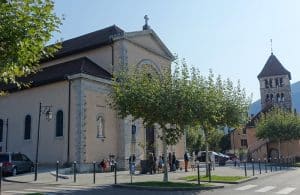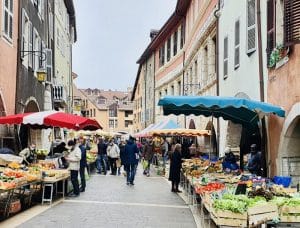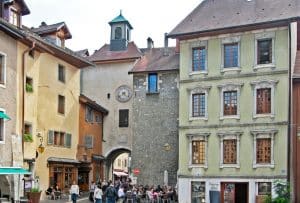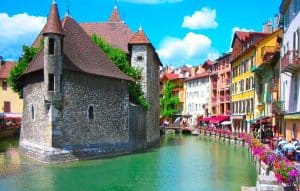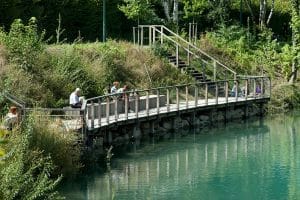The visit of the Old Town of Annecy is easy as all the monuments are grouped in the same area. There is no slope so access is easy for pushchairs and people with reduced mobility.
The historic centre of the little Venice of the Alps took off in the 12th century. Before that, the people of Annecy lived on the heights of Annecy-le-Vieux and Gevrier. The presence of the Thiou river allowed various craft activities to develop. But the houses were built of wood and many fires ravaged the town in a very short time. In the 15th century, the Duke of Savoy asked the inhabitants to build their houses in stone to avoid these disasters. During your visit to the Old Town of Annecy, the architectural unity of the facades you see is made possible by the various renovations carried out by the owners.
Rue Sainte-Claire
No matter where you enter Annecy, you will walk through many narrow streets. Buildings of yellow, pink and green colours, created in the Middle Ages, follow one another. Rue Saint-Claire, the main street, is distinguished by its arcades which offer many shaded restaurants. These arcades date from the 16th and 17th centuries. They are an architectural model of Renaissance urbanization.
In the 15th century, Annecy suffered several fires, but the town was rebuilt. The timber-framed houses were replaced by stone houses with arcades that allowed pedestrians to circulate and merchants to set up their stalls. The middle of the street is dedicated to the circulation of horse-drawn vehicles. You can appreciate the variety of facades in this street, most of which retain their medieval charm.
By crossing the Thiou, you will reach the rue Jean-Jacques Rousseau where the Cathédrale Saint-Pierre is located. It was here that the writer learned music and met Madame de Warrens. The magnificent fountain of the Golden Baluster at number 10 of this street is a testimony to this.
Numerous small perpendicular streets will allow you to reach the Château d’Annecy.
Be careful, to reach the Castle from the Old Town, the slope is steep. It is possible to park in the public car park of the Château, located 200 metres from the flat road.
The Perrière and Saint-Claire gates
If you go to the end of the Rue Saint-Claire, you will discover first the Porte Pérrière and then thePorte Saint-Claire, the limit of the Old Town. These gates bear witness to the time when this fortified passageway was used to enter the city by paying a tax.
The Old Prisons
The Perrière Bridge allows you to take an emblematic photo, that of the Old Prisons, also known as the Palais de l’île. This monument, which was in turn a prison, a chancellery and a court house, can be visited like a museum. It is surrounded by the river Thiou, which, by following it, will take you to the Jardin de l’Europe, a wooded park where you can admire the Île des Cygnes. You can then cross the Pont des Amours, which spans the Vassé canal, to reach the Pâquier, a green park opposite the lake.
The Thiou, a small river that crosses the Old Town
This river, which rises in the Vassé canal, has several kilometres of landscaped banks and offers a beautiful walk from Annecy to Cran-Gevrier. Discover the Thiou.
False friends : What is the difference between the old Annecy and Annecy-le-Vieux ?
